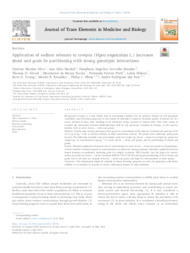Application of sodium selenate to cowpea (Vigna unguiculata L.) increases shoot and grain Se partitioning with strong genotypic interactions.
Application of sodium selenate to cowpea (Vigna unguiculata L.) increases shoot and grain Se partitioning with strong genotypic interactions.
Author(s): SILVA, V. M.; NARDELI, A. J.; MENDES, N. A. C.; ALCOCK, T. D.; ROCHA, M. de M.; PUTTI, F. F.; WILSON, L.; YOUNG, S. D.; BROADLEY, M. R.; WHITE, P. J.; REIS, A. R. dos
Summary: Backgorund: Cowpea is a crop widely used in developing countries due its rusticity. Besides its rich genotypic variability, most breeding programs do not explore its potential to improve elements uptake. Selenium (Se) is a scarce element in most soils, resulting in its deficiency being common in human diets. This study aimed to evaluate the interaction between biofortification with Se and genotypic variation in cowpea, on the concentrations of Se in roots, leaves + stem and grains.
Publication year: 2021
Types of publication: Journal article
Unit: Embrapa Mid-North
Observation
Some of Embrapa's publications are published as ePub files. To read them, use or download one of the following free software options to your computer or mobile device. Android: Google Play Books; IOS: iBooks; Windows and Linux: Calibre.
Access other publications
Access the Agricultural Research Database (BDPA) to consult Embrapa's full library collection and records.
Visit Embrapa Bookstore to purchase books and other publications sold by Embrapa.

